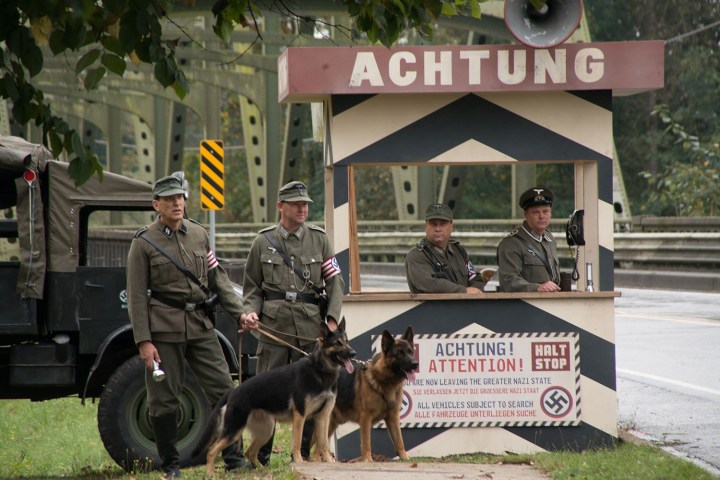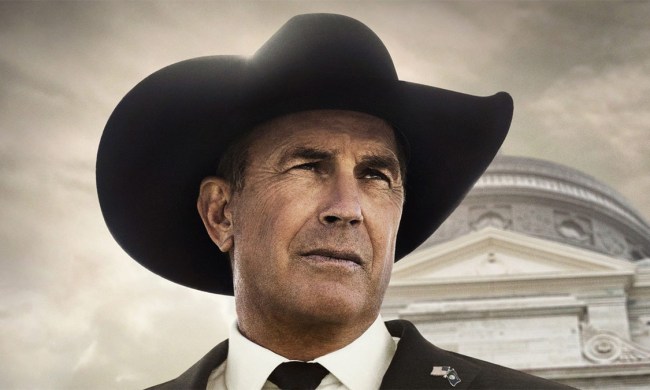
“One thing everybody can agree on: We don’t want to be occupied by the Nazis.”
The world can be a dark, dark place at times, but it’s even darker in Philip K. Dick’s disturbingly dystopian novel, The Man in the High Castle, wherein the Axis powers won World War II and America finds itself divided under the rule of The Nazis in the East and Japan in the West.
Dick’s chilling themes are both explored and expanded upon in the Amazon Original series The Man in the High Castle, whose entire first 10-episode season is streaming now on Amazon, and it’s free for Amazon Prime subscribers.
The show’s simmer-to-a-boil plot structure lends itself to can’t-help-it binge-watching, and with that, it also brings forth a score of hot-button and quite contemporary cultural issues — none of which are lost on series creator and showrunner Frank Spotnitz (The X-Files). “The reason to do this series is to reflect on the world we live in now,” he says. “The subject matter is really challenging. It’s difficult, and it risks offending a lot of people too.”
Spotnitz realizes he has a deep responsibility to examine all sides of the racial divisiveness inherent in this world. “I’ve been really sensitive to that, and tried to be as thoughtful as I can,” he continues. “This is a fiction show, but when you’re dealing with Nazi-ism and the extermination of Jews and blacks — people take this very personally.
“I’m also aware there are people out there who may be rooting for the wrong side in the show. It’s a tough balance, because I want to humanize these people. Too often we look at them and go, ‘Oh, those Nazis over there; they’re the bad guys.’ In this show, most of the Nazis have American accents, and you realize they weren’t all psychopaths. Most of them were normal people who somehow got persuaded to do really terrible, terrible things. And that makes us very uncomfortable. That’s what the show’s really about.”
Digital Trends sat down with Spotnitz and key members of The Man in the High Castle cast at the New York Comic Con last month to discuss how best to watch the show, its deepening cultural impact, and what its future may hold.
Digital Trends: You can stream The Man in the High Castle via Amazon, of course, but what’s the best way to watch the show — on a phone, a laptop, a tablet, or a big-screen TV?
Frank Spotnitz (creator and showrunner): I’d say watch it on the biggest TV or the best monitor you can get. It’s beautifully lit by our cinematographers. It’s dark and it’s shot in 4K ultra-high resolution, so if you’re watching on a not-very-good screen, it’s not the best way to look at it.
“I haven’t plotted it like a typical TV series. It’s one story, told over 10 hours.”
Alexa Davalos (Juliana Crane, freedom seeker): Watch it in whatever way you want. That’s the beauty of these things nowadays — you don’t have to be at home on a Friday at 5 o’clock to watch it. You can have it on the go, you can watch it on a plane, or you can have it in your pocket. To have that access to this world — on any device at any time, at any place — is really beautiful.
I’m a massive bookworm and I know a lot of people who don’t read as much anymore; they watch television in the way that we would read a book. This show — it’s the modern-day novel, in a sense. People are watching as many episodes as they want, just as they would read as many chapters as they want.
Should you watch it all at once, or over a period of time?
Davalos: I don’t know… To each their own, I think. It does have those qualities that make you want to press that button and see what happens next. That’s the beauty of it. To savor it and stretch it out would be quite cool as well, I think, yeah.

Joel de la Fuente (Japanese Chief Inspector Kido, man with a mission): If it’s at all possible, I’d watch it on as big a screen as you could. I’m fans of both our cinematographer Gonzala Amat and our production designer Drew Broughton. They are excellent at what they do, and they’re shooting it in 4K with that in mind.
But because of the format that it’s shot, I also think it’s a personal thing. One of the things I love about Amazon and streaming media — it’s like a great book. And whatever your relationship with that book, you should follow your heart with that. Meaning, when I have a great book and I have two hours to sit down and read it, that’s great. But sometimes, you want to stay up all night with it and say, “Screw it — I have work tomorrow, but I want to sit down and read it all, or watch it all at once.”
Giving the power to the viewer of how you’re going to consume what it is that you choose to consume is a fantastic thing. (pauses) I’d watch it all at once on my TV, though. (all laugh)
“This is about the fascist values in our country.”
But people are used to watching things on the computer. It’s how they consume — and good for them. It’s not something I’m willing to do.
This show could never have survived on a major network. It was the right time for it. This show could only be done now, because we need a platform like Amazon to allow us to make it. I don’t think the show could even survive on cable because we’re not ad-dependent. We’re subscriber-based. And I don’t think Amazon is concerned about viewership, necessarily. They’re concerned about doing something they’re proud of and the prestige that comes with it, which is an amazing thing.
Let’s talk about the post-war/early-’60s look of the show, and also how it impacts you personally when you look at its iconography.
Spotnitz: Some of the early concept art I got sent was for beer, pretzels, and hot dogs, and I went, “No no no no — that’s not what this is about.” There’s nothing wrong with beer and hot dogs (chuckles), but this is about fascist values in our country.
So what are the signs? The Nazis would have been about agriculture and industry, and state control. You look at Times Square today or in the ’60s, and it’s about capitalism and all its glory. Right? Chaotic capitalism. This world is something else, and that’s the kind of thing I’m looking for in the show.
What’s the difference between us and them, and why does it matter? What do we stand for? Who are we? We’re so angry with each other right now. The left and the right are so polarized and so rigid, and so far apart. But the one thing everybody can agree on is: We don’t want to be occupied by Nazis. We can all agree we’re against Nazis, right?
There are scenes in the show where you go, “I almost agree with that, with what that guy is saying — but I don’t!” Why not? That’s exciting to me.
“We have our finger on the pulse of something that should be part of a global conversation.”
Davalos: It’s so surreal, but the most surreal moment is how normal it was, because we’re so immersed in what we’re doing. That world is what we lived and breathed for six months. But now that we’ve had time to step back from it, we think, “My God, it’s shocking.” It was normal to see all that every day — but it’s not normal, you know what I mean?
The scope of the sets, and the detail, was perfect to period. I’ve never seen that before in my life — that level of attention. There was no “mock” anything. It was just magic. Everything was so visceral and palpable that it didn’t allow room for questioning.
Qualls: Those images are not a stunt. They’re the things that exist in this world. Otherwise, the show would be 20 minutes long. The subject matter is heavy.
Shooting the pilot was interesting because the iconography of all the Nazi stuff is really jarring. After a while, it just becomes part of your “normal,” and then it’s all about playing the story. We’re doing something good and different, and I hope that we don’t fuck it up. And I hope people embrace it.
De la Fuente: When you see Japanese soldiers wearing that uniform with that armband, there’s a visceral reaction — and we welcome that. We want people to have whatever feeling they’ll have there. And the hope is, through specific characters, if we do our jobs well and we create realistic, complex characters, we’ll slowly start to challenge your ideas about what’s good and what’s bad, and hopefully pull you into an interesting mix of gray.

We have to live life with the feeling of some sort of inevitability to our lives, but this show challenges that, which makes it sort of exciting. It’s not so inevitable. There is a collective sense that we’ve created something that’s really interesting. We feel like we have our finger on the pulse of something that should be part of a national or global conversation where people will be entertained and engaged, and want to talk about it.
How long do you see the show running?
Davalos: Frank is a genius at serialized television. He knows exactly how little to expose, and how much. It’s been a very slow build, and that’s very much his intention. We’ve sort of pulled the thread, and it’s unraveling slowly, slowly. He wants it to go on for a very long time, so we have to stretch those unveilings as long as we can.
Spotnitz: I was originally thinking three to five years, but now I’m thinking more. The more you think about the show, it’s about the whole world. If they give me the money, I could go anywhere.
I don’t know how long it will run, but I know where it ends. I know what’s going to happen to Juliana in the end, but I don’t know anything else. There are many, many things to talk about.






